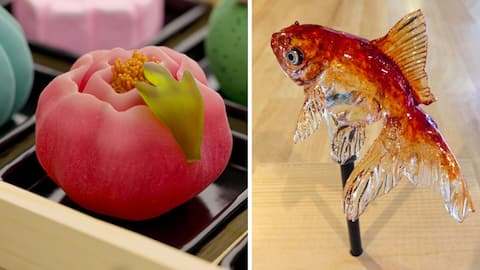Mizuame: The sweet secret behind Japanese confectionery
What's the story
Mizuame, also referred to as "water candy" is a Japanese sweetener characterized by its clear, thick, and sticky liquid form. This sweet substance is utilized in various ways, imparting a glossy finish to wagashi, consumed akin to honey, and even serving as a primary ingredient in confections. Its unique characteristics make it a notable component in the realm of traditional Japanese sweets.
Preparation
How Mizume is prepared
There are two approaches to converting starches into sugars. The traditional method involves combining glutinous rice with malt, allowing the natural enzymatic process to occur, resulting in a syrup primarily composed of maltose. The more prevalent method employs acids to break down potato starch or sweet potato starch to produce glucose syrup However, the former method yields a richer flavor.
Candy
Candy culture in Japan
Japanese appreciation for sweets is evident in meticulous preparation emphasizing taste and aesthetics. Their wide variety of Kit Kat flavors illustrates this. Historical records from Japan's Nara Period (710-794) mention candy, reflecting its consumption 1,300 years ago. The Nihon Shoki (second-oldest book of Japanese history) asserts Japan made candy 2,700 years prior. Initially, Mizuame prevailed, but later black sugar introduced variety in sweet-making
Wagashi
Wagashi, a crucial part of Japanese tea ceremonies
Wagashi, traditional Japanese sweets, are delicate confections made of natural ingredients that showcase seasonal themes. Crafted with precision, they reflect Japan's heritage, combining taste and artistry in diverse shapes and flavors. In tea ceremonies, wagashi complements the bitter notes of tea, creating a harmonious balance of flavors. Although optional, Mizuame's absence alters texture and gloss, influencing the taste and aesthetics of these delightful treats.
Nutrition
Nutritional aspects of Mizuame
Mizuame, linked to the macrobiotic diet rooted in Buddhism, is deemed a healthier option than sugar. It offers trace amounts of iron, calcium, phosphorus, and potassium. Despite being a carbohydrate source providing quick energy, its sugar nature entails health risks, lacking significant benefits beyond its role as a carbohydrate. Mizuame, beyond wagashi, crafts Amezaiku—a form of edible art involving coloring and sculpting candy.
